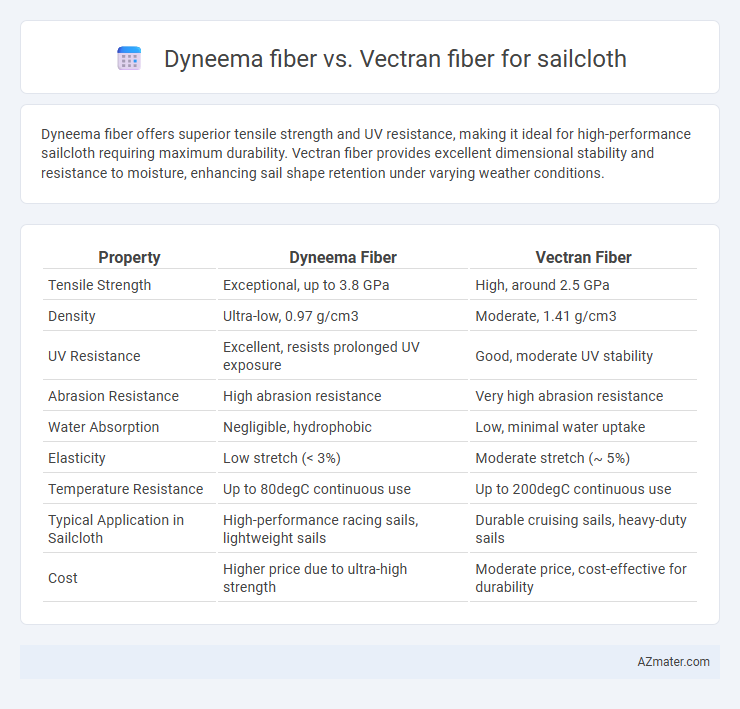Dyneema fiber offers superior tensile strength and UV resistance, making it ideal for high-performance sailcloth requiring maximum durability. Vectran fiber provides excellent dimensional stability and resistance to moisture, enhancing sail shape retention under varying weather conditions.
Table of Comparison
| Property | Dyneema Fiber | Vectran Fiber |
|---|---|---|
| Tensile Strength | Exceptional, up to 3.8 GPa | High, around 2.5 GPa |
| Density | Ultra-low, 0.97 g/cm3 | Moderate, 1.41 g/cm3 |
| UV Resistance | Excellent, resists prolonged UV exposure | Good, moderate UV stability |
| Abrasion Resistance | High abrasion resistance | Very high abrasion resistance |
| Water Absorption | Negligible, hydrophobic | Low, minimal water uptake |
| Elasticity | Low stretch (< 3%) | Moderate stretch (~ 5%) |
| Temperature Resistance | Up to 80degC continuous use | Up to 200degC continuous use |
| Typical Application in Sailcloth | High-performance racing sails, lightweight sails | Durable cruising sails, heavy-duty sails |
| Cost | Higher price due to ultra-high strength | Moderate price, cost-effective for durability |
Introduction to Dyneema and Vectran Fibers
Dyneema fiber, known for its ultra-high molecular weight polyethylene (UHMWPE) composition, offers exceptional strength-to-weight ratio and superior abrasion resistance, making it ideal for high-performance sailcloth applications. Vectran fiber, a liquid crystal polymer (LCP) fiber, provides excellent dimensional stability, high tensile strength, and resistance to creep, enhancing sail durability and shape retention. Both fibers are widely used in advanced sailcloth manufacturing due to their unique properties that improve performance and longevity in demanding maritime environments.
Chemical Composition and Structure
Dyneema fiber, composed of ultra-high-molecular-weight polyethylene (UHMWPE), features a linear polymer structure with extremely high tensile strength and low density, making it highly resistant to abrasion and UV degradation. Vectran fiber, derived from liquid crystal polymer (LCP), exhibits a rigid-rod molecular structure that provides excellent dimensional stability and resistance to creep under load, essential for sailcloth performance. The chemical backbone of Dyneema consists of long chains of polyethylene, whereas Vectran's aromatic rings and ester linkages give it superior thermal stability and resistance to chemicals, impacting durability and maintenance in marine environments.
Tensile Strength Comparison
Dyneema fiber exhibits a tensile strength of approximately 3.6 GPa, outperforming Vectran fiber, which typically ranges between 2.5 to 3.0 GPa, making Dyneema a superior choice for high-performance sailcloth requiring maximum strength-to-weight ratio. Dyneema's ultra-high-molecular-weight polyethylene composition provides exceptional tensile strength and durability, whereas Vectran, a liquid crystal polymer fiber, offers good strength with higher resistance to abrasion and heat. Sailcloth manufacturers prioritize Dyneema fiber when maximum tensile strength and lightweight properties are critical for optimal sailing performance.
UV and Weather Resistance
Dyneema fiber exhibits superior UV resistance and weather durability compared to Vectran fiber, making it highly effective for long-term sailcloth applications exposed to harsh sunlight and marine environments. Vectran fiber offers excellent initial strength but tends to degrade faster under prolonged UV exposure and moisture. Sailcloth constructed with Dyneema maintains tensile strength and flexibility longer, reducing maintenance and replacement costs in demanding outdoor conditions.
Flexibility and Creep Performance
Dyneema fiber offers superior flexibility and exceptional creep resistance in sailcloth applications, maintaining shape and strength under prolonged loads. Vectran fiber provides high initial strength but exhibits greater creep over time, leading to potential distortion in sails. The enhanced dimensional stability of Dyneema ensures longer-lasting performance, especially in dynamic sailing conditions.
Abrasion and Cut Resistance
Dyneema fiber exhibits superior abrasion resistance compared to Vectran fiber, making it ideal for sailcloth exposed to harsh, abrasive conditions. Vectran fiber offers excellent cut resistance due to its inherent strength and stability under sharp impacts, outperforming Dyneema in resisting cuts and slashes. Sailcloth designers often select Dyneema for durability against surface wear and Vectran when enhanced cut protection is critical in performance sails.
Weight and Density Differences
Dyneema fiber boasts a lower density of approximately 0.97 g/cm3 compared to Vectran's density of around 1.41 g/cm3, resulting in significantly lighter sailcloth when using Dyneema. This weight advantage enhances performance by reducing the overall rig load and improving sail responsiveness. Despite its lighter weight, Dyneema also offers high tensile strength, making it a preferred choice for weight-sensitive sailing applications.
Cost and Availability
Dyneema fiber is generally more expensive than Vectran fiber due to its ultra-high molecular weight polyethylene properties that offer superior strength-to-weight ratio and durability in sailcloth applications. Vectran fiber, a liquid crystal polymer, provides a cost-effective alternative with good tensile strength and moderate UV resistance, making it more readily available in various sailcloth markets. While Dyneema offers unmatched performance for high-end sails, Vectran remains a popular choice for budget-conscious projects seeking reliable performance.
Applications in Modern Sailcloth
Dyneema fiber offers exceptional strength-to-weight ratio and UV resistance, making it ideal for high-performance racing sails and lightweight cruising sails requiring durability and minimal stretch. Vectran fiber provides superior dimensional stability and exceptional resistance to creep, which is crucial for maintaining sail shape in long-distance cruising and competitive sailing under variable wind conditions. Modern sailcloth often integrates Dyneema for its lightweight resilience and Vectran for shape retention, optimizing performance across diverse sailing applications.
Choosing the Right Fiber for Your Sails
Dyneema fiber offers exceptional tensile strength-to-weight ratio and superior UV resistance, making it ideal for lightweight, high-performance sailcloth used in racing and cruising vessels. Vectran fiber provides excellent dimensional stability and resistance to creep, favored in applications requiring durable, shape-retentive sails in varying weather conditions. Selecting between Dyneema and Vectran depends on prioritizing lightweight performance or long-term shape retention for optimal sail efficiency.

Infographic: Dyneema fiber vs Vectran fiber for Sailcloth
 azmater.com
azmater.com